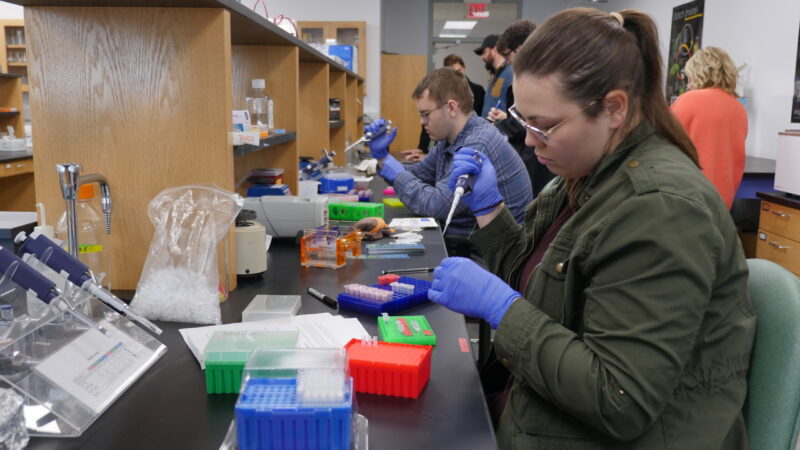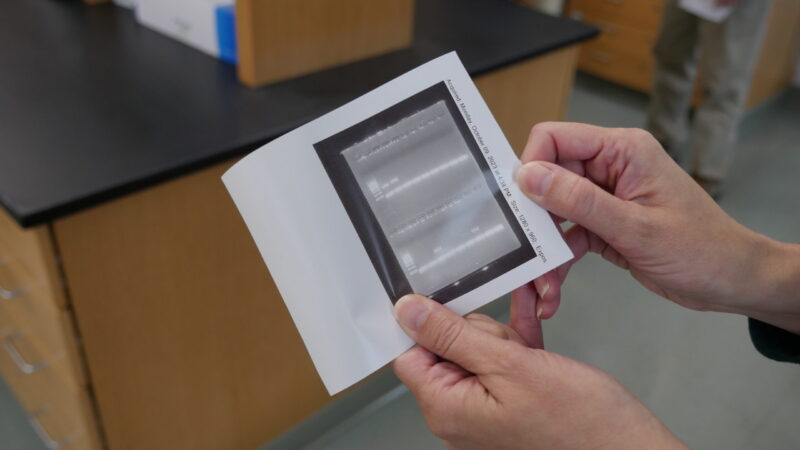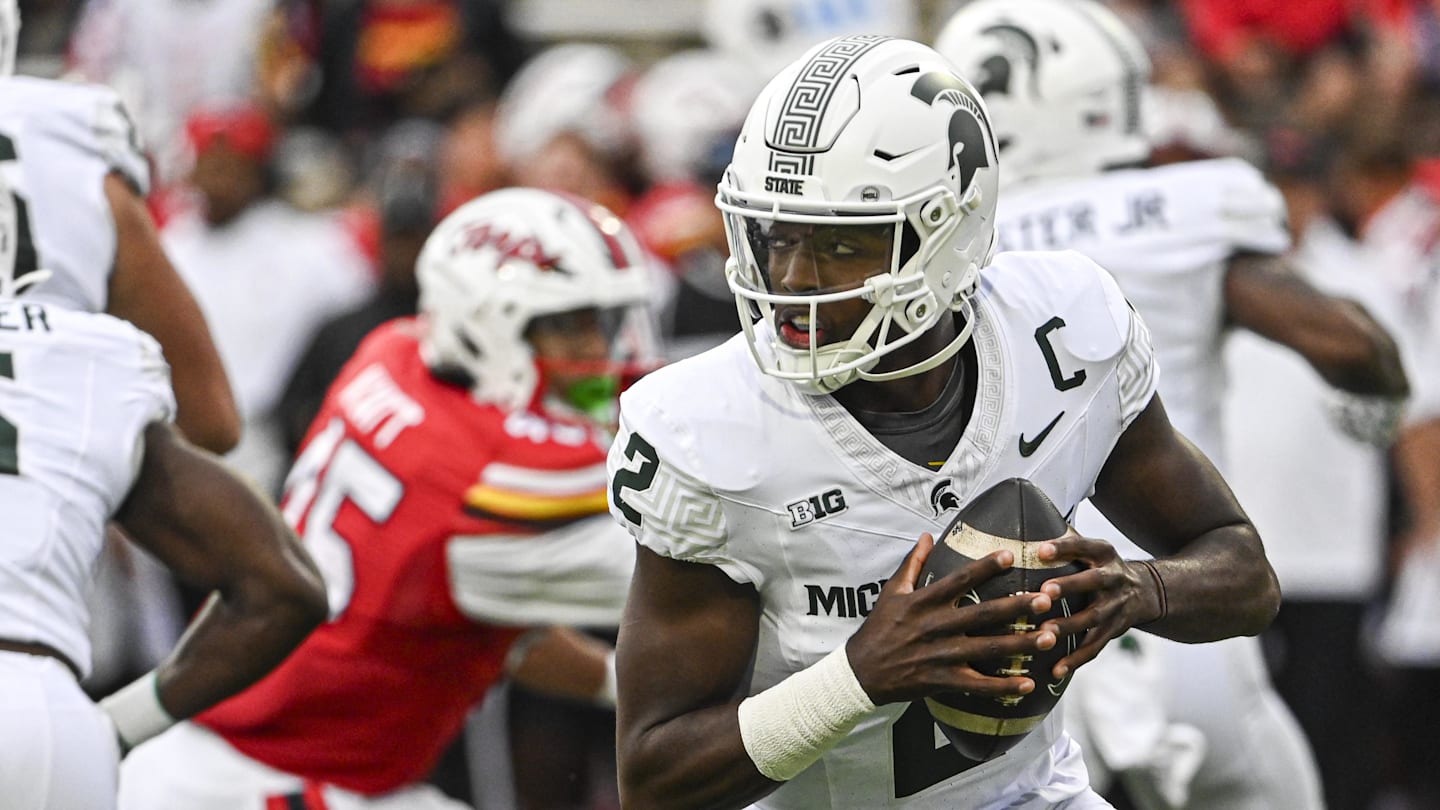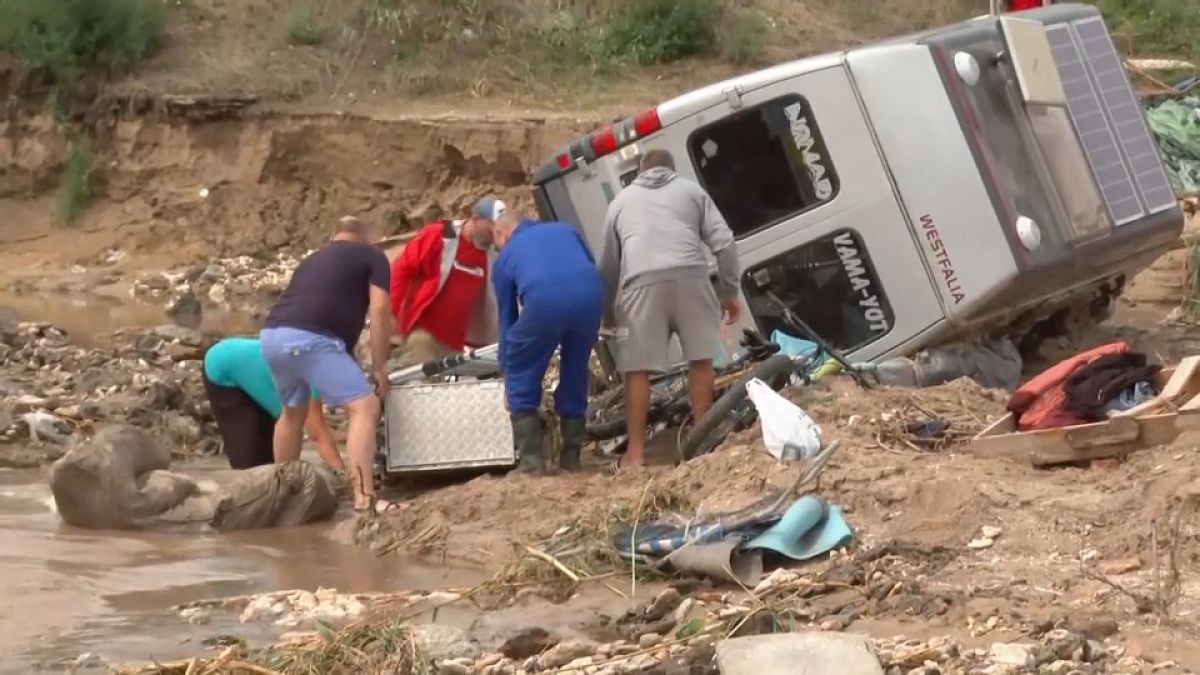Maryland
Researchers Enlist Community Help in Studying Increase of Ticks in Western Maryland

Frostburg State Students Sarah and Alex test ticks for Lyme disease as part of the “Tick Talk” program being led by Frostburg in partnership with the Maryland Department of Natural Resources.
Ticks were once rare in Western Maryland, but the disease-carrying arachnids are on the rise in the region.
The Maryland Department of Natural Resources and Frostburg State University are working together on an initiative to study the rising prevalence of ticks and Lyme disease in western Maryland.
Rebekah Taylor, associate professor and chairwoman for the biology department at Frostburg State University, said ticks were not a concern in Western Maryland when she was growing up there. But things have changed. She started studying ticks after her son contracted Lyme disease.
“I wanted to look into what’s happening in my hometown,” Taylor said while presenting the project at a Tick Talk event Oct. 18 as part of DNR Science Week. “We should talk to people about ticks now because they’re here.”
As part of a citizen science effort, Taylor and Sarah Milbourne, acting western region manager for Maryland Park Service, are asking residents of the region to mail in ticks that they find by taping them onto specially designed postcards. The residents write the date and approximate location where the tick was found on the postcard, and Taylor and her research students identify the ticks and test them for Lyme disease.
They are making their data public on FieldScope, a data visualization website for community science projects, to inform residents about the risks in their community.
Ticks are becoming more common as a result of warmer winters, less intense forest management, and the spread of invasive plant species such as Japanese barberry–a favorite home of mice, which carry ticks. Research has linked climate change to both expanded ranges and increased seasons of activity for ticks.
Milbourne believes talking about talks is an effective way to communicate the everyday effects of climate change in a region not directly affected by sea-level rise or other prominent climate impacts.
“People care about ticks,” Milbourne said. “It’s something you can point to that has changed.”
Lyme disease, caused by a bacteria carried in blacklegged ticks (also known as deer ticks), leads to headache, fever and fatigue and can affect the heart and nervous system if left untreated. Taylor, who has a background in immunology, said doctors are advised to treat with the assumption of Lyme disease when more than 30 percent of nearby ticks are carrying the bacteria.
In their testing so far, Taylor’s team has found about 40 percent of ticks from the region were positive for Lyme disease.
Taylor said the postcards provide a way for people to play an active part in the research that affects their community. Milbourne plans to place the postcards at state parks, such as Rocky Gap State Park, so visitors can help the project if they encounter a tick on the trails.
In addition to the mailed-in ticks, Frostburg researchers have conducted field surveys by dragging flannel cloths through forested areas to collect ticks. When they remain in wait on the forest floor, ticks are often “questing”–holding two forelegs in the air, ready to grab a passing host–which makes them stick to the cloth.
The deer tick, or black-legged tick, is the most common tick in Maryland and the only one to transmit Lyme. However, other ticks can be vectors for other illnesses. The lone star tick, which has a distinctive white dot on its back, can infect people with ehrlichiosis, tularemia, and Alpha-gal syndrome, which causes an allergy to red meat.
Dog ticks often feed on canines, while the invasive Asian longhorned tick targets cattle and hooved hosts. The latter isn’t dangerous to humans, but it can reproduce without mating, allowing it to expand rapidly and making it difficult to control.
While Lyme disease is associated with a bullseye rash, as much as 30 percent of people infected will not have that telltale symptom, according to the Centers for Disease Control and Prevention. Taylor also cautioned that many tick bites occur during the tick’s nymph stage, when it is smaller and more difficult to see.
Aside from demonstrating a tangible effect of climate change, Milbourne said she also hopes that the initiative provides people with guidance about ticks in their area and how they should be prepared for them.
Taylor said it was important to her that the information they collected was accessible and useful to the public.
“Everybody can have access to see what kind of ticks are in my backyard, what should I be worried about,” she said. “It has a lot of power to it. People can just look this up and find out what’s happening.”
By Joe Zimmermann, science writer with the Maryland Department of Natural Resources.

Tick Life Stages Via Centers for Disease Control and Prevention.

Taylor holds up results of a PCR test that determines whether a tick carries Lyme disease. Photo by AJ Metcalf, Maryland DNR

Frostburg State Students Sarah and Alex test ticks for Lyme disease as part of the “Tick Talk” program being led by Frostburg in partnership with the Maryland Department of Natural Resources.

Maryland
Fall chill overnight for Maryland

Watch CBS News
Be the first to know
Get browser notifications for breaking news, live events, and exclusive reporting.
Maryland
3 Takeaways from the Spartans’ Victory over Maryland

The Michigan State Spartans under head coach Jonathan Smith are 2-0 thanks to a road win against a tough Maryland team, 27-24.
Resilience might be the word to describe this squad so far. The Spartans made some big blunders against the Terrapins and still found a way to battle back. The gritty performance might have been enough to get the Spartans into a bowl game.
Here are three takeaways from the Spartans’ win.
Aidan Chiles: Very Young, Very Talented
Chiles looked vastly improved from the home opener against Florida Atlantic. Again, he looked like an 18-year-old quarterback.
Chiles got not just his first passing touchdown as a Spartan, but three passing touchdowns to go with 24 of 39 passing and 363 yards. He also had three interceptions, which very nearly cost the Spartans the game.
Chiles has about as strong an arm as any quarterback to wear the green and white in recent memory. He is dangerous when he is on the move.
Perhaps a critique is that he should try to make more plays with his legs, he has seemed cautious to these first two games. The first pass rusher to get to Chiles likely won’t bring him down — Chiles has a great feel for the pocket and he is quite slippery.
Chiles overcame some poor mistakes and throwing mechanics (his feet tend to get wide and it factors into his overthrows) to lead the Spartans in the most critical of situations against a sturdy Maryland defense.
Huge game for Chiles, who showed why the hype was so promising.
Can the Spartans Stay Healthy on Defense?
Already, this Spartans squad is beaten up. Dillon Tatum, a key defensive back, lost for the season. Wide receiver Alante Brown, whose injury allowed for Nick Marsh to announce himself to the world, lost for the foreseeable future. Kristian Phillips at guard was huge.
During the Maryland game, several Spartans were beat up. Few even had to go into the tent on the sideline. It will be crucial for the Spartans to remain healthy, especially on defense. Most especially in the defensive backfield.
The Spartans are very confident in their young defensive backs — Justin Denson Jr., Andrew Brinson IV, and Jaylen Thompson can all be very good players, but they need more time to develop.
If more Spartans fall to injury, the defensive backfield could get very young.
Nick Marsh is the Real Deal
Marsh was the recruiting gem of 2024, the best player in a class with plenty of good talent. A highly-rated four-star, Marsh was the No. 107-ranked player in the class by 247Sports. Marsh, of course, stood out in fall camp like the high-profile recruit he was.
6-foot-3, 208 pounds, Marsh already had a man’s body. At just 18 years old.
“Possesses the size, athleticism, and multi-sport profile that projects very well in the long term,” 247Sports’ Gabe Brooks wrote. “Traitsy mismatch wideout with high-major impact potential and the ceiling to develop into an NFL Draft candidate.”
With the loss of Brown, Marsh was asked to step up. Step up he did — eight receptions for 194 receiving yards and a touchdown. Wide receivers coach Courtney Hawkins might have his next in the line of Jalen Nailor, Jayden Reed and Keon Coleman.
Don’t forget to follow the official Spartan Nation Page on Facebook Spartan Nation WHEN YOU CLICK RIGHT HERE, and be a part of our vibrant community group Go Green Go White as well WHEN YOU CLICK RIGHT HERE.
Maryland
Maryland, D.C. and Virginia get more money for house calls for moms and infants – WTOP News

The U.S. Health Resources and Services Administration will provide an additional $23.1 million in federal aid to the agency’s national Home Visiting Program in the District, Maryland and Virginia.
More money is on the way for a home-visiting health care program designed to provide better care for pregnant women, new parents and infants.
The U.S. Health Resources and Services Administration (HRSA) announced an additional $23.1 million in federal aid to the agency’s national Home Visiting Program in the District, Maryland and Virginia.
The extra money is the first time in a decade that the program has received an increase in federal funds, HRSA administrator Carol Johnson said.
“What those resources mean is that we’re able to support nurses, social workers and trained home visitors, and help with those early days of being a new parent,” Johnson said. “All of this has been shown to really make a difference in kids’ outcomes. Kids are so much stronger because they get these kinds of supports.”
Johnson said the program’s success hinges on convenient health visits in a comfortable at-home setting.
“When you’re a new parent, if you have to take off from work and take a few buses to get to an appointment, you’re probably not going to do it,” she said. “But if that person comes to your house and they’re full of resources and knowledge, it’s going to make a huge difference to you.”
Rockville, Maryland-based HRSA spearheads the national program, teaming up with local health organizations to target and reach parents.
Home health care workers can provide breastfeeding support, safe sleep tips and developmental screening for babies. They can even help parents find key services like affordable child care or job and educational opportunities.
“It’s changed my life,” past program participant Fatima Ray said.
Ray said she was introduced to the program in 2015 when she needed help with her infant daughter. She and her husband were first-time parents and stumbled through the first few months with a newborn.
“It felt good, like I had someone on my team,” Ray said. “Those questions you forget to ask the doctor sometimes, she would answer them.”
The experience impressed Ray so much that she became a home health visitor. She is the maternal health coordinator at Primo Center, a homeless shelter for families in Chicago.
“The same care that was given to me, I just want to pass it on,” Ray told WTOP. “I know how much it made a difference in my life. Home visiting matters.”
President Joseph Biden signed bipartisan legislation in 2022 that doubles funding for the program over five years. The move was part of a campaign promise to lower risks linked to pregnancy and improve maternal health, especially among women in rural, tribal and low-income communities.
The national home visiting program will receive $440 million Maryland’s local programs will get $10 million of those funds. Virginia is slated to receive $11 million and D.C.’s home visiting programs will see a $2.5 million increase.
“This will push home visiting forward a lot more,” Ray said. “It’s just going to help tremendously.”
Get breaking news and daily headlines delivered to your email inbox by signing up here.
© 2024 WTOP. All Rights Reserved. This website is not intended for users located within the European Economic Area.
-

 Politics1 week ago
Politics1 week agoTrump impersonates Elon Musk talking about rockets: ‘I’m doing a new stainless steel hub’
-

 World1 week ago
World1 week agoBrussels, my love? Is France becoming the sick man of Europe?
-

 Politics1 week ago
Politics1 week agoTrump campaign slams Harris as 'still a San Francisco radical' after CNN interview
-

 Politics1 week ago
Politics1 week agoHarris says no regrets about defending Biden fitness for office
-

 World1 week ago
World1 week agoLocals survey damage after flooding in eastern Romania
-

 World1 week ago
World1 week agoWhy is Belgium struggling to name a European Commissioner?
-
:max_bytes(150000):strip_icc():focal(722x354:724x356)/Angelina-jolie-becomes-maria-callas-100923-01-2cce48d3de044c459234fd2c2ef1e0d7.jpg)
:max_bytes(150000):strip_icc():focal(722x354:724x356)/Angelina-jolie-becomes-maria-callas-100923-01-2cce48d3de044c459234fd2c2ef1e0d7.jpg) Movie Reviews1 week ago
Movie Reviews1 week ago'Maria' Reviews: What Critics Are Saying About Angelina Jolie's Transformation and Singing as the Opera Diva
-

 World7 days ago
World7 days agoTaiwan court orders release of ex-Taipei mayor arrested in corruption probe

















